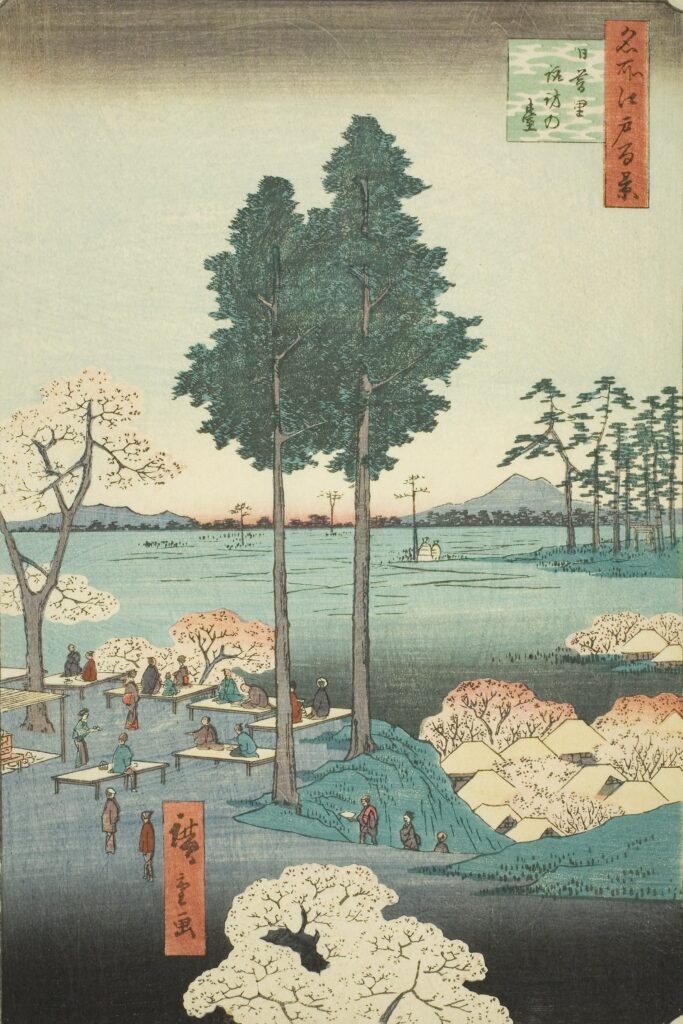
Utagawa Hiroshige – One Hundred Famous Views of Edo – 15 – Spring – Nippori Suwanodai – Commentary 歌川広重-名所江戸百景-15-春-日暮里諏訪の台 解説
Current Address: Nishi-Nippori 3-chome, Arakawa Ward, near Suwa Shrine
Latitude and Longitude: Latitude 35.73078: Longitude 139.76716
Published: May 1856 Age: 60
Commentary
<1> Introduction
“Nippori Suwanodai” depicts the view from a hill in Nippori, located in the northeastern part of Edo.
The work embodies the charm of Nippori, a beloved leisure destination for commoners at the time.
This area, a small hill centered around Suwa Shrine, was an elegant place surrounded by many temples, samurai residences, and commoners’ villas.
In this work, Hiroshige’s free-flowing composition captures the Nippori landscape, where the people of Edo simultaneously enjoyed three activities: escaping the summer heat, sightseeing, and religious activities.
<2> Nippori and Suwa-no-dai
The name “Nippori” is said to have come from the saying, “If you spend the whole day here, the view is so beautiful that the sun sets.”
Suwa Shrine is enshrined on a hill in Nippori.
It is said to have been enshrined from Suwa Taisha Shrine in Nagano and Shinano, and has long been worshipped as the guardian deity of the area.
“Dai” refers to a plateau or high ground.
This is the grounds of Suwa Myojin Shrine, said to have been built in 1322.
The location where Suwa Shrine is enshrined offers a scenic view of Ueno and Honjo.
It was a perfect vantage point for the people of Edo.
<3> Highlights of the Painting
The grounds and trees of Suwa Shrine are in the foreground, with views of Edo city in the distance and even Mount Fuji beyond.
The painting combines perspective, a technique favored in Edo painting, with a view of Mount Fuji.
Depicting people visiting the shrine and common people strolling around, the painting offers a glimpse into the daily lives of Edo people, where faith and leisure were one and the same.
The shrine buildings and groves are simplified yet have a strong presence, indicating that they were centers of faith.
The deep green and the clear brightness of the sky evoke the refreshing seasons from summer to early autumn.
One can imagine Edo commoners escaping the heat and enjoying the cool breeze.
The two magnificent cedar trees in the center suggest that this is the temple grounds.
Suwanodai offers an open view to the northeast.
As can be seen, it overlooks the rows of houses in Nippori Village, and beyond the vast fields, one can see the Nikko Mountains and Mount Tsukuba.
There is even a hanging teahouse where tea is served to people seated on the floor.
During the time of Ota Dokan, it was also used as a temporary residence for Edo Castle.
<4> Nippori Suwa no Dai for the Edo Commoner
Compared to central Edo, Nippori was well-ventilated and had more greenery, making it a popular summer destination.
With Suwa Shrine and many other temples nearby, it was a standard day trip combining pilgrimages with sightseeing.
Haiku poets, tanka poets, and artists visited the area and incorporated it into their poetry and paintings. It was also a place where Edo culture thrived.
<5> Modern-day “Suwa no Dai”
Today, Suwa Shrine is enshrined in Nishi-Nippori, Arakawa Ward, and is beloved as the local guardian deity.
The area bustles with activity during festivals, allowing you to feel the traditions of the Edo period.
Although high-rise buildings are on the rise in Tokyo today, views of the city can still be seen from Suwa Shrine and the surrounding slopes, allowing you to experience the “view from high ground” of the past.
The Nippori area, including Suwa-no-dai, is a popular tourist destination known as “Yanesen,” along with Yanaka, Nezu, and Sendagi. Many people visit this area to experience the temple town and downtown atmosphere.
<6> Tourist Guide
1. Visit Nippori Suwa Shrine
Visit the shrine and imagine it as a reflection of Hiroshige’s paintings of Edo landscapes.
2. Explore the Temple Town
Heading from Suwa Shrine toward Yanaka, you can stroll through many temples.
3. Eat Your Way Through Yanaka Ginza
Just as Edo commoners enjoyed sightseeing, today, enjoy the food of the shopping district.
4. Literary Stroll
Nearby are the settings of modern literary works by Shiki Masaoka and Ogai Mori, making this area ideal for a cultural stroll.

